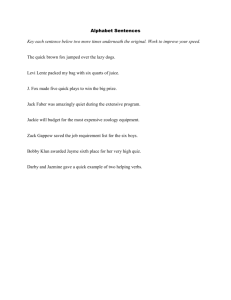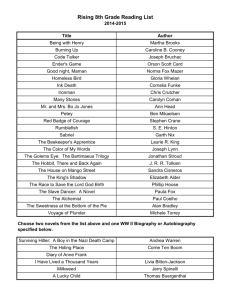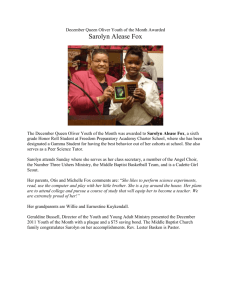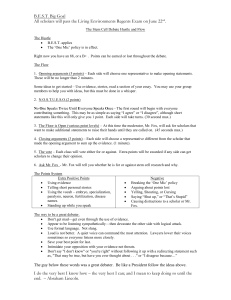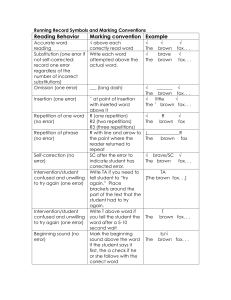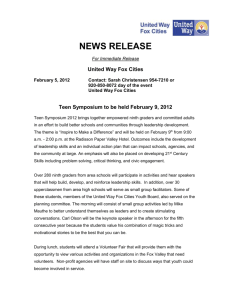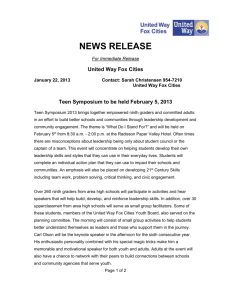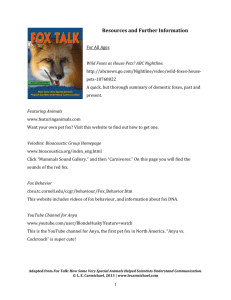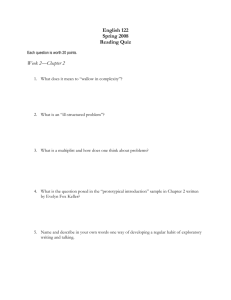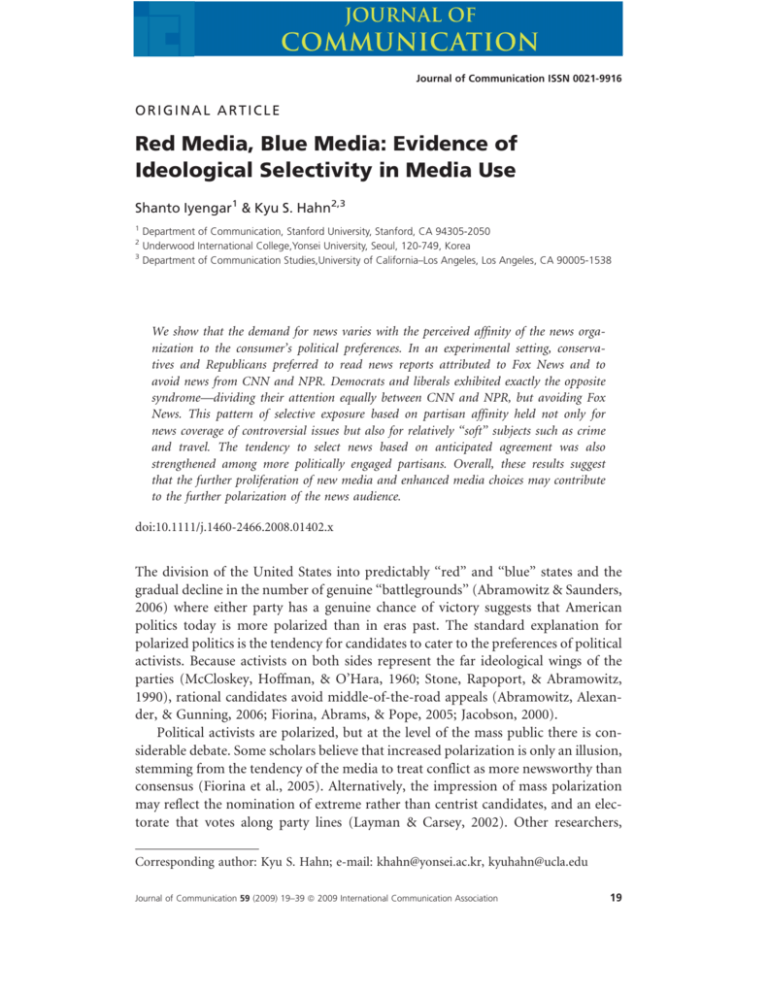
journal of
COMMUNICATION
Journal of Communication ISSN 0021-9916
ORIGINAL ARTICLE
Red Media, Blue Media: Evidence of
Ideological Selectivity in Media Use
Shanto Iyengar1 & Kyu S. Hahn2,3
1
Department of Communication, Stanford University, Stanford, CA 94305-2050
Underwood International College,Yonsei University, Seoul, 120-749, Korea
3
Department of Communication Studies,University of California–Los Angeles, Los Angeles, CA 90005-1538
2
We show that the demand for news varies with the perceived affinity of the news organization to the consumer’s political preferences. In an experimental setting, conservatives and Republicans preferred to read news reports attributed to Fox News and to
avoid news from CNN and NPR. Democrats and liberals exhibited exactly the opposite
syndrome—dividing their attention equally between CNN and NPR, but avoiding Fox
News. This pattern of selective exposure based on partisan affinity held not only for
news coverage of controversial issues but also for relatively ‘‘soft’’ subjects such as crime
and travel. The tendency to select news based on anticipated agreement was also
strengthened among more politically engaged partisans. Overall, these results suggest
that the further proliferation of new media and enhanced media choices may contribute
to the further polarization of the news audience.
doi:10.1111/j.1460-2466.2008.01402.x
The division of the United States into predictably ‘‘red’’ and ‘‘blue’’ states and the
gradual decline in the number of genuine ‘‘battlegrounds’’ (Abramowitz & Saunders,
2006) where either party has a genuine chance of victory suggests that American
politics today is more polarized than in eras past. The standard explanation for
polarized politics is the tendency for candidates to cater to the preferences of political
activists. Because activists on both sides represent the far ideological wings of the
parties (McCloskey, Hoffman, & O’Hara, 1960; Stone, Rapoport, & Abramowitz,
1990), rational candidates avoid middle-of-the-road appeals (Abramowitz, Alexander, & Gunning, 2006; Fiorina, Abrams, & Pope, 2005; Jacobson, 2000).
Political activists are polarized, but at the level of the mass public there is considerable debate. Some scholars believe that increased polarization is only an illusion,
stemming from the tendency of the media to treat conflict as more newsworthy than
consensus (Fiorina et al., 2005). Alternatively, the impression of mass polarization
may reflect the nomination of extreme rather than centrist candidates, and an electorate that votes along party lines (Layman & Carsey, 2002). Other researchers,
Corresponding author: Kyu S. Hahn; e-mail: khahn@yonsei.ac.kr, kyuhahn@ucla.edu
Journal of Communication 59 (2009) 19–39 ª 2009 International Communication Association
19
Red Media, Blue Media
S. Iyengar & K. S. Hahn
however, point to evidence that increasing numbers of ordinary citizens have
migrated to the opposite ends of the liberal–conservative scale. Between 1972 and
2004, for instance, the average difference in ideological self-placement between nonactivist Democrats and Republicans more than doubled (Abramowitz & Saunders,
2006).
An alternative indicator of political polarization—and one that also suggests
increased polarization at the mass level—is the intensification of partisan attitudes.
There is a wealth of time series data tracking Americans’ evaluations of the incumbent president. These data show that on balance, Democrats’ and Republicans’
negative evaluations of a president of the other party have steadily intensified
(Abramowitz & Saunders, 2006; Jacobson, 2006). The approval data document
a widening partisan chasm between Republicans and Democrats; the percentage of
partisans who respond at the extremes (‘‘strong approval’’ or ‘‘strong disapproval’’)
has increased significantly over time. In fact, polarized assessments of presidential
performance are higher today than at any other time in recent history, including the
months preceding the resignation of President Nixon. In this sense at least, mass
public opinion is polarized.
Media consumption as an antecedent of polarization
It is no mere coincidence that the trend toward a more divided electorate has occurred
simultaneously with the revolution in information technology. Forty years ago,
the great majority of Americans got their daily news from one of three network
newscasts. These newscasts offered a homogeneous and generic ‘‘point–counterpoint’’
perspective on the news, thus ensuring that exposure to the news was a common
experience. The development of cable television and the explosion of media outlets
on the Internet have created a more fragmented information environment in which
cable news, talk radio, and 24-hour news outlets compete for attention. Consumers
can access—with minimal effort—newspapers, radio, and television stations the
world over. Given this dramatic increase in the number of available news outlets,
it is not surprising that media choices increasingly reflect partisan considerations.
People who feel strongly about the correctness of their cause or policy preferences
seek out information they believe is consistent rather than inconsistent with their
preferences.
The revival of selective exposure
The argument that people prefer to approach supportive over nonsupportive information precedes the onset of new media and dates back to the heyday of cognitive
consistency theories in the 1950s (Festinger, 1957). The theory predicted that as
a means of minimizing dissonance, people would seek out information they expected
to agree with. Given the nonpartisan, ‘‘objective’’ content of mainstream American
press coverage, early tests of this hypothesis focused on exposure to political campaigns rather than news and documented the tendency of partisan voters to report
20
Journal of Communication 59 (2009) 19–39 ª 2009 International Communication Association
S. Iyengar & K. S. Hahn
Red Media, Blue Media
greater exposure to appeals from the candidate or party they preferred (Lazarsfeld,
Berelson, & Gaudet, 1948; Schramm & Carter, 1959; Sears & Freedman, 1967). This
pattern of exposure to in-party appeals was considered the principal explanation for
the reinforcing effects of campaigns (Klapper, 1964).1
An important theoretical limitation of the early work on selective exposure was
that it failed to distinguish between deliberate or motivated exposure and ‘‘de facto’’
exposure that was a by-product of voters’ personal networks or social context. Highincome voters, for instance, might have encountered more pro-Republican messages
not because they actively screened out information about the Democrat, but because
their friends and neighbors were disproportionately Republican (Cotton, 1985;
Sears & Freedman, 1967).
More direct tests of whether people deliberately avoid exposure to disagreeable
information yielded mixed results suggesting that dissonance avoidance was a relatively weak motive for the acquisition of information (McGuire, 1968; Sears, 1968).
Although some controlled studies uncovered traces of motivated exposure to inparty sources (Bartlett, Drew, Fahle, & Watts, 1974; Iyengar & McGrady, 2007;
Stempel, 1961; Sweeney & Gruber, 1984), others did not (Chaffee & Miyo, 1983;
Meffert, Chung, Joiner, Waks, & Garst, 2006; Sears, 1968). Moreover, the preference
for congenial information seemed to occur under limited circumstances (Frey,
1986). For example, people first asked to make a decision and then presented with
information choices tended to select information consistent with their decision
(Jonas, Schulz-Hardt, Frey, & Thelen, 2001).
The fact that researchers have been hard pressed to detect consistent traces of
partisan selective exposure among American voters is attributable in part to the
evolving institutional context of campaigns. As political campaigns became less
controlled by political parties and more media based (Polsby, 1983), voters found
it increasingly difficult to encounter partisan messages or messengers (Mutz & Martin,
2001). Instead, they encountered the same ‘‘point–counterpoint,’’ unbiased media
coverage no matter where they turned (Allen & D’Alissio, 2000). But, this overtly
neutral media environment changed dramatically with the diffusion of cable television and the Internet. The new, more diversified information environment makes it
not only more possible for consumers to seek out news they might find agreeable but
also provides a strong economic incentive for news organizations to cater to their
viewers’ political preferences (Mullainathan & Schleifer, 2005). The emergence of
Fox News as the leading cable news provider is testimony to the viability of this
‘‘niche news’’ paradigm. Between 2000 and 2004, although Fox News increased the
size of its regular audience by some 50%, the other cable providers showed no growth
(Pew Research Center for the People and Press, 2004).2
A growing body of evidence suggests that consumers are in fact exercising greater
selectivity in their news choices. In the first place, in keeping with the well-known
‘‘hostile media’’ phenomenon (Gunther, Christen, Liebhart, & Chia, 2001; Vallone,
Ross, & Lepper, 1985), partisans of either side have become more likely to impute
bias to mainstream news sources (Smith, Lichter, & Harris, 1997). Cynical
Journal of Communication 59 (2009) 19–39 ª 2009 International Communication Association
21
Red Media, Blue Media
S. Iyengar & K. S. Hahn
assessments of the media have surged most dramatically among conservatives;
according to a Pew Research Center for the People and the Press survey, Republicans
are twice as likely as Democrats to rate major news outlets including the three
network newscasts, the weekly news magazines, NPR, and PBS as biased (Pew
Research Center for the People and Press, 2004). As indicated by the recent furor
over The New York Times’ front-page story suggesting an inappropriate relationship
between Senator John McCain and a female lobbyist (Rutenberg, Thompson, & Kirkpatrick, 2008), critical coverage from a source viewed as biased becomes a rallying
event for supporters of the targeted candidate. In the immediate aftermath of the
publication of the report, the McCain campaign set a record for the amount of
money raised online (Bumiller, 2008).
In response to their perceptions of hostile bias in the mainstream media environment, partisans of both sides have begun to explore alternative sources of news. A
study of self-reported media exposure during the 2000 and 2004 campaigns uncovered significant evidence of differential media use among Republicans and Democrats (Pfau, Houston, & Semmler, 2007). Republicans gravitated to talk radio, radio
news, and television advertising, whereas Democrats avoided talk radio and tuned in
to television news magazines and late-night entertainment television (Pfau et al.,
2007, pp. 36–38).
In short, there is growing evidence that in the new media environment, partisans
attribute bias to mainstream news outlets and gravitate to alternative sources perceived as more congenial to their preferences. But are these perceptions grounded in
reality? Put differently, is there evidence that ‘‘new’’ media do in fact deliver more
slanted or biased news? At least in the case of Fox News, the answer is in the
affirmative.
In its relatively short life span, Fox News has staked out a distinctive reputation for
delivering a proconservative perspective on issues and events. A systematic comparison
of Fox News’ coverage of national issues with the coverage provided by other new
media and two ‘‘old’’ media (AP and UPI) demonstrated that Fox News’ reputation
was deserved—the outlet’s news coverage showed a consistently pro-Republican slant
(Groeling & Baum, 2007). Despite the fact that real-world conditions generated significantly more ‘‘bad news’’ stories about Republican candidates contesting the 2006
congressional elections (due mainly to the series of lobbying-related scandals involving
Republican incumbents), Fox News was the only news outlet in which negative stories
about Republicans did not outnumber balanced or positive stories. Unlike previous
studies of media bias in which the key indicator of bias is not news content per se but
some proxy for content (Gentzkow & Shapiro, 2006; Groseclose & Milyo, 2005), this
study provides direct content-based evidence of ideological slant in Fox News. The
availability of Fox News, in fact, makes it possible for Republicans and conservatives to
seek out a more sympathetic perspective and, conversely, to avoid exposure to discordant points of view.
Given the evidence concerning partisans’ perceptions of Fox News and the actual
slant conveyed by the outlet, we may anticipate significant behavioral (as opposed to
22
Journal of Communication 59 (2009) 19–39 ª 2009 International Communication Association
S. Iyengar & K. S. Hahn
Red Media, Blue Media
self-reported) differences between partisan groups in exposure to Fox News: Conservatives and Republicans should seek it out while Democrats and liberals do the
opposite. Moreover, given the current political environment, we further anticipate
that an ‘‘approach–avoidance’’ behavioral pattern will vary across the subject matter
of news reports. In a world of polarized news consumers, conservatives should most
prefer exposure to Fox News when the subject of the news is some controversial
policy issue (e.g., the war in Iraq). They might also prefer Fox coverage when the
news focuses on less politicized subjects (e.g., healthcare or travel), but to a lesser
degree.
Method
Experimental design
We designed an online experiment to investigate the extent to which partisans on the
right treat Fox News as a preferred provider. More specifically, we observed whether
attention to the identical news story was increased or decreased when the story was
attributed to Fox News, NPR, CNN, or the BBC.
Using the MSNBC daily news feed (which includes reports from a wide variety of
news organizations), we randomly assigned news stories to one of four sources—
Fox, NPR, CNN, or BBC. We attained the maximum level of realism by providing
participants with the most recent news stories in real time. Study participants were
provided with a brief headline accompanied by the logo of the news organization and
asked to indicate (by clicking a box) which of four reports displayed on the screen
they would like to read. Because respondents could also click a ‘‘Can’t Say’’ box, each
respondent had a choice between five alternatives. They repeated this task across six
different subject matter categories evenly divided between ‘‘hard’’ and ‘‘soft’’ topics.
The former included reports on American politics (e.g., the relations between President Bush and Democrats in Congress), the war in Iraq, and race relations. The soft
topics included crime, travel, and sports. We also included a baseline or control
condition in which all source logos were deleted; here participants could only choose
between the reports based on the text of the accompanying headlines.
In the analyses that follow, the control condition formed the baseline to which
the selection rate of news stories in the treatment condition was compared. Any
difference in the rate of selecting a particular story between the control and treatment
conditions can only be attributed to the presence or absence of the source label
because the same set of stories were provided to both groups.
All other aspects of the presentation were equalized across the different conditions. For instance, the placement of a particular story or news source on the screen
was randomized so that no particular source gained from being the first or last on the
screen. Stories and sources were randomly matched. Thus, the design was fully
counterbalanced on order, story headline, and news logo. The study was run between
March 30 and April 16, 2006. The total sample of news stories was 383. Because the
MSNBC feed features more rapid daily replacement of stories on political issues
Journal of Communication 59 (2009) 19–39 ª 2009 International Communication Association
23
Red Media, Blue Media
S. Iyengar & K. S. Hahn
(i.e., Iraq and politics), the sample included more stories on Iraq and politics (60 and
71, respectively) than the more specialized topics of race and travel (40 and 11,
respectively).
The sample
Using the services of Polimetrix—an opinion research firm—we administered the
experiment on a nationally representative sample of 1,023 (772 and 251 assigned to
the treatment and control conditions, respectively) registered voters. Polimetrix has
developed a new methodology for sampling from pools of opt-in respondents (the
sampling methodology is available at www.polimetrix.com). Their two-stage procedure first draws a conventional probability sample a large-scale random digit
dialing (RDD) sample (the target sample).3 Next, for each member of the target
sample, Polimetrix selects one or more matched members from their pool of opt-in
Internet respondents. This is called the matched sample. Polimetrix implements
matching—searching for an available opt-in respondent who is as similar as possible
to the corresponding member of the target sample—using the variables of race,
gender, age, education, and imputed party identification and ideology. The end
result is a sample of opt-in respondents with equivalent characteristics as the target
sample on the matched characteristics listed above; under most conditions, the
matched sample will converge with a true random sample (Rivers, 2005).4
Hypotheses
Given the lineup of news sources, we naturally hypothesized that the demand for
news stories would be heightened among Republicans and those with conservative
political views when stories were labeled as Fox reports. Conversely, we expected
participants on the left of the political spectrum to show greater interest in stories
assigned to CNN or NPR. Even though CNN and NPR both claim to be committed
to nonpartisan and objective reporting (as does Fox), in the context of the four
sources available to study participants, the content provided by CNN and NPR more
closely matched the preferences of Democrats than the content provided by Fox. And
since the BBC is a foreign news source with a well-known reputation for independent
journalism, we expected uniform indifference for the BBC label among Democrats,
Republicans, and nonpartisans alike.
We further hypothesized that the effects of the source manipulation would be
stronger for political subject matter where partisan divisions are intense, but weaker
when the news dwelled on nonpolitical subjects such as travel destinations or sporting events.
Based on the polarization literature, we also hypothesized that the source manipulation would be weakened among less attentive partisans and those with no party
preference since they are likely to be unaware of the partisan slant of particular news
outlets, while more attentive partisans are well aware of the partisan location of Fox,
NPR, or CNN. Thus, we expected that the interaction of political interest and
24
Journal of Communication 59 (2009) 19–39 ª 2009 International Communication Association
S. Iyengar & K. S. Hahn
Red Media, Blue Media
ideology/partisanship would significantly affect news selection—more interested
conservatives, for instance, would display stronger preferences for Fox.
Analysis
Our dependent variable consisted of five ‘‘unordered’’ choices. An unordered choice
situation is one in which outcomes cannot be scaled, that is, outcome A does not
necessarily denote more of the underlying concept than outcome B, and B more than
C for all observations. Thus, the appropriate analytic tool is an unordered choice
model in which individuals choose the option that gives them the most utility. For
the ith individual with j choices, the utility of the jth choice can be given by: Uij =
Xijb 1 uij. Because this individual’s choice reveals his preference, if any individual i
chooses j, then the utility of j is great than the utility from all other options, say, k.
Although multinomial logit (Agresti, 1996; Maddala, 1983) is the conventional
way of modeling random utility functions, it is unsuitable for the current choice
problem at hand. In multinomial logit (MNL), the explanatory variables (X), being
characteristics of an individual, are themselves constant across the choice alternatives.5 A limitation of the MNL model is that it allows only one response function
(the type of restriction imposed on the dependent variable) for all independent
variables in the model. In practice, this means that MNL cannot be used to examine
a choice situation where choices can be attributed to characteristics of the choice
alternatives. That is, the basic MNL model typically permits only individual-specific
attributes to be included as covariates. On the other hand, we specify that Pr(Yi = j) is
a function of both alternative- and individual-specific attributes and their interactions. More specifically, in our current study, the key alternative-specific attributes
are the labels associated with the different news reports respondents encountered,
whereas the individual attribute of primary interest is respondents’ political ideology.6
A more flexible specification of choice functions is provided by the conditional
logit model (Long, 1997; Maddala, 1983; McFadden, 1974). Conditional logit is
appropriate for examining situations in which a choice among alternatives is treated
as a function of the characteristics of the alternatives in addition to the characteristics
of the individual making the choice. More succinctly, the conditional logit model can
be written as follows:
Pij 5
expðX ij aÞ
;
+ expðX ik aÞ
J
k51
where Xij indicates variables measuring the characteristics of alternative J relative to
individual i and disturbances uij, are assumed to be independent across alternatives.
In McFadden’s conditional logit model,7 variables characterizing the choices (i.e.,
the categories of the dependent variable in the MNL model) can be included as
covariates. In other words, news story attributes that differ across alternatives but
Journal of Communication 59 (2009) 19–39 ª 2009 International Communication Association
25
Red Media, Blue Media
S. Iyengar & K. S. Hahn
are constant across respondents within an alternative can be in the vector of explanatory variables since they could be reasons for choosing one alternative over another.
Accordingly, the conditional logit model partitions covariates into (a) alternativespecific attributes of the choices (such as news story labels) and (b) characteristics of
the individual (such as education, party identification, etc.). To estimate the effects
of some individual characteristic, the researcher typically creates j 21 dummy variables for choices and interacts each of them with an individual-level attribute variable.8 Intuitively, conditional logit groups together the alternatives in each
participant’s choice set (or menu). A binary outcome variable shows which alternative was actually picked; it is a dummy variable equal to 1 for the alternative at which
the respondent matriculated and 0 for all of the other alternatives.
McFadden’s conditional logit model has been applied to a wide variety of choice
situations including employer preferences for characteristics of employees (e.g.,
Logan, 1996), consumer preferences for product attributes (Berry, 1994), employees’
choice of health insurance plans (e.g., Parente, Feldman, & Christianson, 2004),
voters’ candidate choices (e.g., Adams & Merrill, 2000; Cutler, 2004), government
formation in parliamentary democracies (e.g., Martin & Stevenson, 2001), or, in the
canonical example, preferences for transportation options (e.g., McFadden, 1974).9
Results
Overall effects of news labels
Prior to assessing the degree of partisan polarization in news selection, we begin by
considering the simple main effects of the source labels. We constructed four dummy
variables (coded 0 or 1) denoting each of the four news sources: (a) FOX, (b) CNN,
(c) NPR, and (d) BBC. We further included an indicator variable denoting those who
answered ‘‘can’t say’’ (ABST). Table 1 displays the coefficient estimates from a conditional logit model predicting the selection of news stories with the individual-level
data. As noted above, the selection rate of ‘‘unlabeled’’ news stories forms the baseline in our analysis. Thus, the four dummy variables—FOX, NPR, CNN, and BBC—
capture differences in the selection rate associated with the presence of each label in
any given subject matter dimension.
Overall, the results suggest that news source labels are an important cue for
readers. Fourteen of the 24 coefficient estimates presented in Table 1 were positively
signed and statistically significant (p , .05). These results indicate that, holding
constant the content differences of news stories, the presence of a news organization
label increases the appeal of news stories across all subject matter dimensions. Consumers tend to ignore ‘‘anonymous’’ news reports.
The Fox label had the strongest impact on story selection in five of the six issue
dimensions examined. As can be seen from Table 1, for the categories of politics, race
relations, Iraq, sports, and crime, the Fox label increased the likelihood of respondents selecting news stories beyond that of nonlabeled stories. More formally, we
tested the null hypothesis H0: bFOX = bk,10 where k is the second largest coefficient
26
Journal of Communication 59 (2009) 19–39 ª 2009 International Communication Association
.613 (.267)*
.223 (.271)
.306 (.270)
.125 (.272)
2.908 (.219)**
1,023
155.88**
.047
.743 (.201)**
.373 (.206)
.380 (.206)
.346 (.206)
2.056 (.160)
1,023
47.84**
.015
Race
Relations
.981 (.229)**
.407 (.236)
.643 (.233)**
.469 (.235)*
2.401 (.180)*
1,023
128.75**
.039
Iraq
.645 (.166)**
.083 (.184)
.403 (.173)*
2.280 (.201)
1.933 (.131)**
1,023
765.89**
.233
Sports
.767 (.203)**
.451 (.207)*
.438 (.207)*
.438 (.207)*
2.056 (.160)
1,023
48.16**
.015
Crime
Soft News Dimension
.360 (.168)*
.375 (.167)*
.435 (.166)**
.287 (.169)
1.057 (.128)**
1,023
138.10**
.042
Travel
Note: Cell entries are given as conditional logit estimates with their standard errors (SE) in parenthesis. Coefficient estimates show deviations in
news selection rates from the baseline in labeled conditions.
*p , .05. **p , .01.
FOX
NPR
CNN
BBC
ABST
N
Likelihood ratio x2
Pseudo
R2
Politics
Hard News Dimension
Table 1 Baseline Versus Labeled Conditions (conditional logit estimates)
S. Iyengar & K. S. Hahn
Red Media, Blue Media
Journal of Communication 59 (2009) 19–39 ª 2009 International Communication Association
27
Red Media, Blue Media
S. Iyengar & K. S. Hahn
estimate in any given topical dimension. As shown in Table 2, the null hypothesis
was rejected in four of five cases: politics (x 21 = 9.53, p , .01), race relations (x 21 =
11.90, p , .01), Iraq (x 21 = 11.80, p , .01), and crime (x21 = 9.02, p , .01). On the
other hand, in the case of travel news where CNN proved to be the most popular
source based on the point estimates, the null hypothesis H0: bFOX = bCNN could not
be rejected (x21 = .38, n.s.), indicating that CNN was not necessarily more popular
than Fox in the case of travel news. All told, these results indicate that among the four
news organizations included in the current study, the Fox label was the most appealing. Clearly, Fox’s strategy to cater to a conservative audience has worked to increase
its market share.
Evidence of selective exposure in news selection
Next, we turn to assessing the role of respondent attributes in news story selection,
that is, who chose which news stories to read? Of course, our primary focus was to
assess whether respondents’ ideological leanings induced a polarizing effect in news
selection. As a first-cut at the data, we plotted story selection rates with and without
source labels for Republicans, Independents, and Democrats (Figure 1). Here, the
unit of analysis is the individual news story and the selection rate is the proportion of
respondents clicking on this story. As described earlier, one-quarter of the study
participants were provided with the news reports without source labels. Therefore,
we can compare the fraction of the study participants who selected the same story
when it was either unlabeled, or attributed to Fox, CNN, or NPR.
Figure 1 provides considerable evidence of political selectivity: The very same
news story on crime or Iraq or politics or racial issues attracts a different audience
when labeled as a Fox, CNN, or NPR report. Consistent with our expectations, the
effects of the Fox label were weakened for nonpolitical news. Nonetheless, the effects
of the Fox label nearly doubled the selection rate for travel and sports stories among
Republicans. While Republicans were drawn to the Fox label, they avoided CNN and
NPR. On average, the probability that a Republican would select a CNN or NPR
Table 2 Formal Tests of Labeling Effects (Wald test statistics)
Hard News
Hard News
Politics
Race relations
Iraq
Soft news
Sports
Crime
Travel
Null Hypothesis
x 21
p Value
H0: bFOX = bCNN
H0: bFOX = bCNN
H0: bFOX = bCNN
9.53
11.90
11.80
p , .01
p , .01
p , .01
H0: bFOX = bCNN
H0: bFOX = bNPR
H0: bCNN = bFOX
3.11
9.02
.38
n.s.
p , .01
n.s.
Note: Test statistics concern the differences between the largest and second largest coefficient
estimates in each subject matter category.
28
Journal of Communication 59 (2009) 19–39 ª 2009 International Communication Association
S. Iyengar & K. S. Hahn
Red Media, Blue Media
0.600
Hard News
Soft News
Selection Rate
0.500
0.400
Democrats
Independents
Republicans
0.300
0.200
0.100
0.000
Fox
News
No CNN/NPR
Source
Fox
News
No CNN/NPR
Source
Fox
News
No CNN/NPR
Source
Figure 1 Effects of story label on story selection.
report was around 10%. As for the Democrats, they were just as averse to Fox as the
Republicans were to CNN and NPR. But unlike the Republicans, they did not seem
to converge on a particular news source. Although the CNN and NPR labels boosted
interest among Democrats, the effects appeared somewhat weak.
Next, we proceed to a more rigorous test of the polarization hypotheses based on
individual rather than story-level data. More specifically, we created interaction
terms between the respondent’s self-reported political ideology11 (IDE) and the
Fox, NPR, CNN, and BBC labels.12 Note that no individual attributes are included
in the vector of explanatory variables by themselves. As explained earlier, this is
because the respondent’s own characteristics remain the same regardless of the
choice he makes, so they cannot—on their own—be a reason for choosing one news
story over another; it is only when they are interacted with news story attributes (or
choice-specific attributes such as the source labels) that they can influence the
respondent’s choice.
Our results demonstrate that the divide in news selection between conservatives and
liberals is considerable. As shown in Table 3, in every subject matter dimension but one,
the FOX 3 IDE interaction was positive,13 and four of the coefficients were statistically
significant at the p = .01 level. These findings suggest that the Fox label attracted
a disproportionately large number of conservatives when holding the content of news
stories constant. In sharp contrast, all the coefficient estimates for other news outlets
(i.e., CNN, NPR, and BBC) were negative, and 10 of 18 were statistically significant.
As a further test of polarization in news selection, we conducted Wald tests of the
difference between the most and the second-most positive coefficient estimates in
each subject matter dimension (see the three middle columns in Table 4). After Fox,
conservatives preferred NPR in politics, BBC in race relations and Iraq, and CNN in
the three soft news subjects (i.e., sports, crime, and travel). As shown in Table 4, the
null hypotheses were clearly rejected (p , .01), meaning that the difference between
Journal of Communication 59 (2009) 19–39 ª 2009 International Communication Association
29
30
22.537 (.769)**
23.143 (.849)**
23.079 (.841)**
22.208 (.816)**
2.972 (.228)**
.897 (.218)**
1.025 (.237)**
1.029 (.239)**
.727 (.232)**
.183 (.138)
2.466 (.140)**
2.456 (.141)**
2.551 (.143)**
978
300.05**
.095
.214 (.729)
2.608 (.836)
.282 (.791)
.633 (.775)
2.095 (.165)
.163 (.197)
.081 (.215)
.329 (.226)
2.022 (.212)
2.051 (.105)
2.633 (.111)**
2.693 (.111)**
2.595 (.111)**
978
162.06**
.052
2.435 (.803)
21.101 (.887)
2.948 (.850)
2.328 (.840)
2.464 (.187)*
.314 (.221)
.453 (.233)*
.419 (.243)
.229 (.232)
.514 (.119)**
2.181 (.118)
2.242 (.123)*
2.177 (.121)
978
254.71**
.081
2.306 (.672)
21.518 (.938)
2.524 (.759)
.599 (.798)
1.917 (.133)**
.182 (.180)
.255 (.203)
.444 (.250)
2.245 (.223)
.498 (.089)**
2.141 (.086)
2.163 (.097)
2.172 (.116)
978
778.22**
.247
1.344 (.850)
1.130 (.886)
1.770 (.866)*
1.222 (.883)
2.123 (.167)
2.227 (.227)
2.386 (.232)
2.192 (.237)
2.222 (.236)
.461 (.100)**
2.035 (.101)
2.157 (.100)
2.101 (.100)
978
129.42**
.041
.142 (.725)
1.736 (.666)**
1.850 (.647)**
1.249 (.708)
1.046 (.130)**
2.017 (.194)
2.385 (.175)*
2.375 (.181)*
2.268 (.192)
.414 (.094)**
2.270 (.082)**
2.346 (.085)**
2.397 (.088)**
978
223.41**
.071
Travel
Note: Coefficient estimates show deviations in news selection rates from the baseline in labeled conditions. IDE = ideology, PI = political interest.
*p , .05. **p , .01.
FOX
NPR
CNN
BBC
ABST
FOX 3 PI
CNN 3 PI
NPR 3 PI
BBC 3 PI
FOX 3 IDE
CNN 3 IDE
NPR 3 IDE
BBC 3 IDE
N
Likelihood ratio x2
Pseudo R2
Crime
Sports
Iraq
Politics
Race Relations
Soft News Dimension
Hard News Dimension
Table 3 Antecedents of News Selection: Conditional Logit Estimates
Red Media, Blue Media
S. Iyengar & K. S. Hahn
Journal of Communication 59 (2009) 19–39 ª 2009 International Communication Association
2.33
3.11
1.44
4.73
1.07
3.06
bNPR = bBBC
bNPR = bBBC
bCNN = bBBC
bNPR = bBBC
bCNN = bNPR
bFOX = bCNN
x22
p , .05
n.s.
n.s.
n.s.
n.s.
n.s.
p Value
bFOX = bCNN
bFOX = bCNN
bFOX = bCNN
bFOX = bNPR
bFOX = bBBC
bFOX = bBBC
Nulla Hypothesis
31.88
32.41
41.89
55.77
38.50
59.81
x22
Interactions with Ideology
p , .01
p , .01
p , .01
p , .01
p , .01
p , .01
p Value
bCNN = bBBC
bCNN = bNPR
bCNN = bBBC
bNPR = bBBC
bNPR = bBBC
bNPR = bBBC
Nullb Hypothesis
.05
1.96
1.67
1.12
1.20
.48
x22
n.s.
n.s.
n.s.
n.s.
n.s.
n.s.
p Value
b
Fox versus non-Fox organization with the most (least) positive (negative) coefficient estimates.
The most (least) positive (negative) coefficient estimate versus the second- most (least) positive (negative) coefficient estimate among non-Fox
channels.
a
Hard news
Politics
Race relations
Iraq
Soft news
Sports
Crime
Travel
Null Hypothesis
Interactions with Political Interest
Table 4 Formal Tests of Polarization: Wald Test Statistics
S. Iyengar & K. S. Hahn
Red Media, Blue Media
Journal of Communication 59 (2009) 19–39 ª 2009 International Communication Association
31
Red Media, Blue Media
S. Iyengar & K. S. Hahn
Table 5 Polarization Among the More Interested: Likelihood Ratio Tests
Hard news
Politics
Race relations
Iraq
Soft news
Sports
Crime
Travel
LR x24
p Value
5.23
10.31
11.96
.265
.036
.018
.89
4.18
5.42
.926
.382
.247
Note: Test statistics concern the significance of the increase in the model’s log-likelihood after
including four 3-way interaction terms between the channel, ideology, and political interest.
Fox and the second-most selected source were consistently significant for conservatives, thus adding to the case for ideology-based polarization in news selection.
It is worth noting that ideological polarization occurred in all six subject areas.
As expected, the test statistics shown in Table 4 reveal that the divide between
conservatives and liberals proved considerably larger in the hard news dimension
(i.e., politics, race relations, and the war in Iraq) when compared with the soft
news categories (i.e., sports, crime, and travel). Nonetheless, a considerable ideological divide was apparent even in exposure to soft news. Conservatives prefer
Fox even when reading about vacation destinations, whereas liberals avoid Fox
when the focus is sports. These findings illustrate the pervasiveness of the ideological
divide in news selection.
For purposes of comparison, we also tested the equivalent null hypotheses concerning interactions between political interest and the four news outlet dummies (see
the first three columns in Table 4). Here, we applied much looser criteria (for the
purpose of finding any traces of division between the more and the less interested) by
testing the difference between the most and the least positive coefficient estimates.
We detected no consistent pattern of polarization by interest; the null hypothesis
could be rejected in only one (sports) of the six subject matter dimensions. These
contrasting results suggest that our findings of the ideological divide in news selection do not stem from some unknown methodological artifact.
It is also worth noting that liberals did not converge on a single source; instead
they divide their selections between the non-Fox News channels making little distinction among them. To pursue this question further, we again conducted Wald
tests to detect any significant differences between non-Fox News channels by choosing a pair of non-Fox News organizations with the largest difference among liberals
in terms of the point estimates (see the last three columns in Table 4).14 As shown in
Table 4, none of the tests revealed any statistically significant differences; liberals
have a strong aversion to Fox, but no particular affinity for any of the non-Fox
sources.
32
Journal of Communication 59 (2009) 19–39 ª 2009 International Communication Association
S. Iyengar & K. S. Hahn
Red Media, Blue Media
Are more involved partisans more selective?
Next, we turn to testing a higher order version of the polarization hypothesis,
namely, that polarization is intensified among the more engaged strata. As noted
earlier, some contend that polarization is limited to activists, whereas the general
public remains centrist (e.g., Fiorina et al., 2005). We tested this prediction by
creating 3-way interaction terms between respondents’ political interest, ideology,
and the four news outlet dummies. The significance of these interactions tells us
whether polarization occurs at a differential rate for more and less interested partisans. Although most of the 3-way interaction terms proved nonsignificant, at least in
the case of two hard news subjects (politics and the war in Iraq), the interactions
proved significant. For example, in the case of news stories about politics, the more
interested conservatives (liberals) avoided (preferred) CNN (b = 2.372, p , .05).
Similarly, the more involved conservatives (liberals) preferred (avoided) Fox News
(b = .348, p , .05) in the case of the Iraq war.
We also tested the statistical significance of the four 3-way interaction terms as
a block in each topical dimension. That is, for each subject matter category, we tested
the significance of the differences in the likelihood of the full and reduced models
before and after including all four 3-way interaction terms. As shown in Table 5, the
results provide at least partial support for the ‘‘greater polarization among activists’’
hypothesis. Although the increase in the likelihood ratio was marginal in four of the
six topical dimensions, it proved statistically significant in the cases of more contentious topics such as race relations and the war in Iraq. These findings suggest that
the polarization pattern is especially pronounced among the more interested, at least
when the media cover controversial issues. When the media turn to relatively nonpolitical subjects, more and less engaged conservatives and liberals are equally
divided in their news choices.
Conclusion
No matter how we sliced the data—either at the level of individuals or news stories—
the results demonstrate that Fox News is the dominant news source for conservatives
(the results presented above are equally strong if we substitute party identification for
ideology). Although Fox’s brand advantage for conservatives is especially strong
when the news deals with politicized subjects, it also applies to subject matter typically not associated with partisan division. Indeed, the most surprising of our findings is the substantial level of polarization in exposure to soft news.
The emergence of Fox News as the cable ratings leader suggests that in a competitive market, politically slanted news programming allows a new organization to
create a niche for itself. Recent theoretical work in economics shows that under
competition and diversity of opinion, newspapers will provide content that is more
biased: ‘‘Competition forces newspapers to cater to the prejudices of their readers,
and greater competition typically results in more aggressive catering to such prejudices
as competitors strive to divide the market’’ (Mullainathan & Schleifer, 2005, p. 18).
Journal of Communication 59 (2009) 19–39 ª 2009 International Communication Association
33
Red Media, Blue Media
S. Iyengar & K. S. Hahn
Thus, as the audience become polarized over matters of politics and public policy,
rational media owners stand to gain market share by injecting more rather than less
political bias into the news (Gentzkow & Shapiro, 2006). The recent experience of
MSNBC is revealing. The network’s most popular evening Countdown with Keith
Olbermann—conveys an unabashedly anti-Bush Administration perspective. The
network now plans to ‘‘to showcase its nighttime lineup as a welcome haven for
viewers of a similar mind’’ (Steinberg, 2007). When the audience is polarized, ‘‘news
with an edge’’ makes for market success.
A further implication of voters’ increased exposure to one-sided news coverage is
an ‘‘echo chamber’’ effect—the news serves to reinforce existing beliefs and attitudes.
During periods of Republican governance, for instance, criticisms of the incumbent
administration conveyed by mainstream news organizations can be dismissed as
evidence of ‘‘liberal bias’’ thus further increasing partisan polarization. After the
revelations in the news media that the Bush Administration’s prewar intelligence
claims were erroneous, Democrats (when asked whether the U.S. had found weapons
of mass destruction (WMD) in Iraq), switched to the ‘‘no WMD’’ response by
a factor of more than 30%. Independents also switched, by more than 10 percentage
points. But Republicans remained steadfast in their beliefs affirming the presence of
WMD—between June 2003 and October 2004 the percentage of Republicans
acknowledging that the United States had not found WMD increased by less than
five points (Iyengar & McGrady, 2007; Kull, Ramsay, & Lewis, 2003).
The importance of source cues to news exposure and the resulting ‘‘reinforcement of priors’’ effect will only grow as technology diffuses and consumers increasingly customize their online news menus. Our results are consistent with the
argument that Internet technology will, in practice, narrow rather than widen users’
political horizons. Although an infinite variety of information is available, individuals may well limit their exposure to news or sources that they expect to find agreeable. Over time, this behavior is likely to become habituated so that users turn to
their preferred sources automatically no matter what the subject matter. The
observed behavior of Republicans in this study may be attributed, in part, to their
20 years of experience with a favored news provider, thus reinforcing their informationseeking behavior. As Democrats and politically inclined independents also begin to
establish media preferences, consumers will be able to ‘‘wall themselves off from
topics and opinions that they would prefer to avoid’’ (Sunstein, 2001, pp. 201–202).
The end result is likely to be a less informed and more polarized electorate.
Selective exposure is especially likely in the new media environment because of
information overload. New forms of communication not only deliver much larger
chunks of campaign information, but they also facilitate consumers’ ability to attend
to the information selectively. The audience for conventional news programs is hard
pressed to avoid coverage of the candidate they dislike because news reports typically
assign equal coverage to each. But when browsing the web, users can filter or search
through masses of text more easily. Thus, as candidates, interest groups, and voters
all converge on the Internet, the possibility of selective exposure to political
34
Journal of Communication 59 (2009) 19–39 ª 2009 International Communication Association
S. Iyengar & K. S. Hahn
Red Media, Blue Media
information increases. As we have found, people prefer to encounter information
that they find supportive or consistent with their existing beliefs.
Notes
1 More recent work has confirmed this pattern. Studies using a dynamic information
board designed to mimic the flow of information during a presidential campaign, for
instance, found that voters on average learned slightly more about the in-party than the
out-party candidate (Lau & Redlawsk, 2006; also see Bartlett et al., 1974).
2 Of course, it is possible that there are also nonpolitical reasons for the competitive edge
enjoyed by the Fox Network.
3 The target sample is drawn from the 2004 American Community Study, conducted by
the U.S. Bureau of the Census, which is a probability sample of size 1,194,354 with
a response rate of 93.1 percent.
4 The fact that the Polimetrix (PMX) sample was matched according to a set of demographic characteristics does not imply that the samples are unbiased. All sampling
modes are characterized by different forms of bias and opt-in Internet panels are no
exception. Systematic comparisons of PMX matched samples with RDD (telephone)
samples and face-to face interviews indicate trivial differences between the telephone
and online modes, but substantial divergences from the face-to-face mode (Hill, Lo,
Vavreck, & Zaller, 2007; Malhotra & Krosnick, 2007). In general, the online samples
appear biased in the direction of politically attentive voters. For instance, in comparison with National Election Study respondents (interviewed face-to-face), PMX
respondents were more likely by eight percentage points to correctly identify the Vice
President of the U.S.
5 Thus, in practice, MNL estimates a set of J 2 1 coefficients (bi) for each individualspecific explanatory variable. The estimated coefficients show the effects of the X
variables on the probability of choosing each alterative relative to one alternative that
serves as a common benchmark.
6 If we were to employ the basic MNL model, control group participants would have to
be dropped from our analysis. This is because the presence of a logo is an alternativespecific attribute, and not everyone encountered these ‘‘unlabeled’’ alternatives. For
clarification, in this case, the baseline category would have to be set as one of the
alternatives labeled as either Fox News, CNN, NPR, BBC, or ‘‘Can’t say,’’ where those
who encountered unlabeled news stories (i.e., control group participants) cannot be
included in the analysis.
7 When the conditional logit model does not include choice characteristics, the likelihood function is equivalent to that of the MNL model, producing the same coefficients
and standard errors.
8 Technically we can only justify using the conditional logit model if we can make the
independence of irrelevant alternatives (IIA) assumption (Alvarez & Nagler, 1996;
Greene, 2003). However, when having five choices, one has to draw from a fourdimensional multivariate normal, and the computation burden becomes excessive in
most cases (Alvarez & Nagler, 1996). Accordingly, we believe that our current analytical
strategy seems most feasible since often the IIA property is neither relevant nor particularly restrictive (Dow & Endersby, 2004).
Journal of Communication 59 (2009) 19–39 ª 2009 International Communication Association
35
Red Media, Blue Media
S. Iyengar & K. S. Hahn
9 As Alvarez and Nagler (1996) note (p. 69), the superiority of the conditional logit
model over multinomial logit is not a new notion in the literature (Agresti, 1990;
Hoffman & Duncan, 1988).
10 For testing for the differences between coefficients, Wald tests (Fox, 1997; Lehmann,
1959) were conducted.
11 We asked, ‘‘When it comes to politics, do you usually think of yourself as liberal,
slightly liberal, moderate or middle of the road, slightly conservative, conservative, or
haven’t you thought much about this?’’ Responses to this question were rescaled to
range between 22 to 2 yielding a 5-point ideology scale. The results are consistent when
we substitute party affiliation for ideology. Instead of creating separate dummy variables for conservatives and liberals, we used an ordered 3-point ideology scale because
the relationship between ideology and channel selection proved linear (Figure 1).
12 We acknowledge that the interaction effects of ideology may represent effects of
unknown variables that are associated with ideology. In order to reduce for possibility
of confounded variables, we reran the analysis controlling for two major predictors of
ideology—age and education. Although not shown here, the results were unchanged,
and these results are available from the authors.
13 From Figure 1, the relationship between partisan preference and channel selection
seemed more or less linear. Accordingly, for parsimony, we did not create separate
dummy variables for conservatives and liberals. Instead, we included a single scale of
the respondent’s political ideology and its interactions with the four news organization
dummies.
14 For example, we chose the NPR–BBC pair in the case of politics; similarly, we chose the
CNN–BBC pair for sports news.
References
Abramowitz, A. I., Alexander, B., & Gunning, M. (2006). Incumbency, redistricting, and
the decline of competition in U.S. House elections. Journal of Politics, 68, 75–88.
Abramowitz, A. I., & Saunders, K. L. (2006). Exploring the bases of partisanship in the
American electorate: Social identity vs. ideology. Political Research Quarterly, 59, 175–187.
Adams, J., & Merrill, S., III. (2000). Spatial models of candidate competition and the 1988
French presidential election: Are presidential candidates vote-maximizers? Journal of
Politics, 62, 729–756.
Agresti, A. (1990). Categorical data analysis. New York: Wiley.
Agresti, A. (1996). An introduction to categorical data analysis. New York: Wiley.
Allen, M., & D’Alissio, D. (2000). Media bias in presidential elections: A meta-analysis.
Journal of Communication, 50, 133–156.
Alvarez, R. M., & Nagler, J. (1996). When politics and models collide: Estimating models of
multiparty elections. American Journal of Political Science, 42, 55–96.
Bartlett, D. L., Drew, P. B., Fahle, E. G., & Watts, W. A. (1974). Selective exposure to
a presidential campaign appeal. Public Opinion Quarterly, 38, 264–270.
Berry, S. T. (1994). Estimating discrete-choice models of product differentiation. RAND
Journal of Economics, 25, 242–262.
Bumiller, E. (2008, February 23). McCain gathers support and donations in aftermath of
article in The Times. The New York Times, p. A13.
36
Journal of Communication 59 (2009) 19–39 ª 2009 International Communication Association
S. Iyengar & K. S. Hahn
Red Media, Blue Media
Chaffee, S. H., & Miyo, Y. (1983). Selective exposure and the reinforcement hypothesis: An
intergenerational panel study of the 1980 presidential campaign. Communication
Research, 10, 3–36.
Cotton, J. L. (1985). Cognitive dissonance in selective exposure. In D. Zillman & J. Bryant
(Eds.), Selective exposure to communication (pp. 11–33). Hillsdale, NJ: Erlbaum.
Cutler, F. (2004). The simplest shortcut of all: Sociodemographic characteristics and electoral
choice. Journal of Politics, 64, 466–490.
Dow, J. K., & Endersby, J. W. (2004). Multinomial probit and multinomial logit: A
comparison of choice models for voting research. Electoral Studies, 23, 107–122.
Festinger, L. (1957). A theory of cognitive dissonance. Stanford, CA: Stanford University Press.
Fiorina, M. P., Abrams, S. J., & Pope, J. C. (2005). Culture wars? The myth of polarized
America. New York: Pearson Longman.
Fox, J. (1997). Applied regression, linear models, and related methods. Thousand Oaks, CA: Sage.
Frey, D. (1986). Recent research on selective exposure to information. In L. Berkowitz (Ed.),
Advances in experimental social psychology (Vol. 19) (pp. 41–80). Orlando, FL: Academic
Press.
Gentzkow, M., & Shapiro, J. M. (2006). Media bias and reputation. Journal of Political
Economy, 114, 280–316.
Greene, W. H. (2003). Econometric analysis (5th ed.). Englewood Cliffs, NJ: Prentice-Hall.
Groeling, T., & Baum, M. A. (2007, August). Barbarians inside the gates: Partisan news media
and the polarization of American political discourse. Paper presented at the annual meeting
of the American Political Science Association, Chicago, IL.
Groseclose, T., & Milyo, J. (2005). A measure of media bias. Quarterly Journal of Economics,
120, 1191–1237.
Gunther, A. C., Christen, C. T., Liebhart, J. L., & Chia, S. C. -Y. (2001). Congenial public,
contrary press, and biased estimates of the climate of opinion. Public Opinion Quarterly,
65, 295–320.
Hill, S., Lo, J., Vavreck, L., & Zaller, J. (2007). The opt-in internet panel: Survey mode, sampling
methodology and the implications for political research. Unpublished manuscript at the
University of California, Los Angeles, California.
Hoffman, S. D., & Duncan, G. J. (1988). Multinomial and conditional logit discrete-choice
models in demography. Demography, 25, 415–427.
Iyengar, S., & McGrady, J. (2007). Media and politics: A citizen’s guide. New York: W.W. Norton.
Jacobson, G. C. (2000). Party polarization in national politics: The electoral connection. In
J. R. Bond, & R. Fleisher (Eds.), Polarized politics (pp. 9–30). Washington, DC: CQ Press.
Jacobson, G. C. (2006). A divider, not a uniter: George W. Bush and the American people.
New York: Pearson.
Jonas, E., Schulz-Hardt, S., Frey, D., & Thelen, N. (2001). Confirmation bias in sequential
information search after preliminary decisions: An expansion of dissonance theoretical
research on ‘selective exposure to information’. Journal of Personality and Social
Psychology, 80, 557–571.
Klapper, J. T. (1964). The effects of mass communication. New York: Free Press.
Kull, S., Ramsay, C., & Lewis, E. (2003). Misperceptions, the media, and the Iraq war. Political
Science Quarterly, 118, 569–598.
Lau, R. R., & Redlawsk, D. P. (2006). How voters decide: Information processing in election
campaigns. New York: Cambridge University Press.
Journal of Communication 59 (2009) 19–39 ª 2009 International Communication Association
37
Red Media, Blue Media
S. Iyengar & K. S. Hahn
Layman, G. C., & Carsey, T. M. (2002). Party polarization and ‘conflict extension’ in the
American electorate. American Journal of Political Science, 46, 786–802.
Lazarsfeld, P. F., Berelson, B. R., & Gaudet, H. (1948). The people’s choice. New York:
Columbia University Press.
Lehmann, E. L. (1959). Testing statistical hypothesis. New York: Wiley.
Logan, J. A. (1996). Opportunity and choice in socially structured labor markets. American
Journal of Sociology, 102, 114–160.
Long, J. S. (1997). Regression models for categorical and limited dependent variables. Thousand
Oaks, CA: Sage.
Maddala, G. S. (1983). Limited-dependent and qualitative variables in econometrics. New York:
Cambridge University Press.
Malhotra, N., & Krosnick, J. (2007). The effect of survey mode and sampling on inferences
about political attitudes and behavior: Comparing the 2000 and 2004 ANES to internet
surveys with non probability samples. Political Analysis, 15, 286–323.
Martin, L. W., & Stevenson, R. T. (2001). Government formation in parliamentary
democracies. American Journal of Political Science, 45, 33–50.
McCloskey, H., Hoffman, P. J., & O’Hara, R. (1960). Issue conflict and consensus among
party leaders and followers. American Political Science Review, 44, 406–427.
McFadden, D. (1974). The measurement of urban travel demand. Journal of Public Economics,
26, 303–328.
McGuire, W. J. (1968). Selective exposure: A summing up. In R. Abelson, E. Aronson, W. J.
McGuire, T. M. Newcomb, M. J. Rosenberg, & P. H. Tannenbaum (Eds.), Theories of
cognitive consistency: A sourcebook (pp. 788–796). Chicago: Rand McNally.
Meffert, M. F., Chung, S., Joiner, A. J., Waks, L., & Garst, J. (2006). The effects of negativity
and motivated information processing during a political campaign. Journal of
Communication, 56, 27–51.
Mullainathan, S., & Schleifer, A. (2005). The market for news. American Economic Review, 95,
1031–1053.
Mutz, D. C., & Martin, P. S. (2001). Facilitating communication across lines of political
difference: The role of the mass media. American Political Science Review, 95, 97–114.
Parente, S. T., Feldman, R., & Christianson, J. B. (2004). Employee choice of consumer-driven
health insurance in a multi plan, multi product setting. Health Service Research, 39,
1091–1112.
Pew Research Center for the People and Press. (2004). Online news audience larger, more
diverse: News audience increasingly polarized. Washington, DC: Pew Research Center for
the People and Press.
Pfau, M. J., Houston, B., & Semmler, S. M. (2007). Mediating the vote: The changing media
landscape in U.S. presidential campaigns. Lanham, MD: Rowman and Littlefield.
Polsby, N. W. (1983). Consequences of party reform. New York: Oxford University Press.
Rivers, D. (2005). Sample matching: Representative sample from internet panels.
Retrieved February 29, 2008, from http://www.polimetrix.com/documents/
Polimetrix_Whitepaper_Sample_Matching.pdf.
Rutenberg, J., Thompson, M. W., & Kirkpatrick, D. D. (2008, February 21). For McCain,
self-confidence on ethics poses its own risk. The New York Times, p. A1.
Schramm, W., & Carter, R. F. (1959). Effectiveness of a political telethon. Public Opinion
Quarterly, 23, 121–26.
38
Journal of Communication 59 (2009) 19–39 ª 2009 International Communication Association
S. Iyengar & K. S. Hahn
Red Media, Blue Media
Sears, D. O. (1968). The paradox of de facto selective exposure without preference for
supportive information. In R. P. Abelson, E. Aronson, W. J. McGuire, T. M. Newcomb,
M. J. Rosenberg, & P. H. Tannenbaum (Eds.), Theories of cognitive consistency: A
sourcebook (pp. 777–787). Chicago: Rand McNally.
Sears, D. O., & Freedman, J. F. (1967). Selective exposure to information: A critical review.
Public Opinion Quarterly, 31, 194–213.
Smith, T. J., III, Lichter, S. R., & Harris, T. (1997). What the people want from the press.
Washington, DC: Center for Media and Public Affairs.
Steinberg, J. (2007, November 6). Cable channel nods to ratings and leans left. The New York
Times, p. A1.
Stempel, G. H. (1961). Selectivity in readership of political news. Public Opinion Quarterly, 25,
400–404.
Stone, W. J., Rapoport, R. B., & Abramowitz, A. I. (1990). The Reagan revolution and party
polarization in the 1980s. In L. S. Maisel (Ed.), The parties respond: Changes in the
American party system (pp. 67–93). Boulder, CO: Westview.
Sunstein, C. R. (2001). Republic.com. Princeton, NJ: Princeton University Press.
Sweeney, P. D., & Gruber, K. L. (1984). Selective exposure: Voter information, preferences,
and the Watergate affair. Journal of Personality and Social Psychology, 46, 1208–1221.
Vallone, R. P., Ross, L., & Lepper, M. R. (1985). The hostile media phenomenon: Biased
perception and perceptions of media bias in coverage of the ‘‘Beirut Massacre.’’ Journal of
Personality and Social Psychology, 49, 577–585.
Journal of Communication 59 (2009) 19–39 ª 2009 International Communication Association
39

